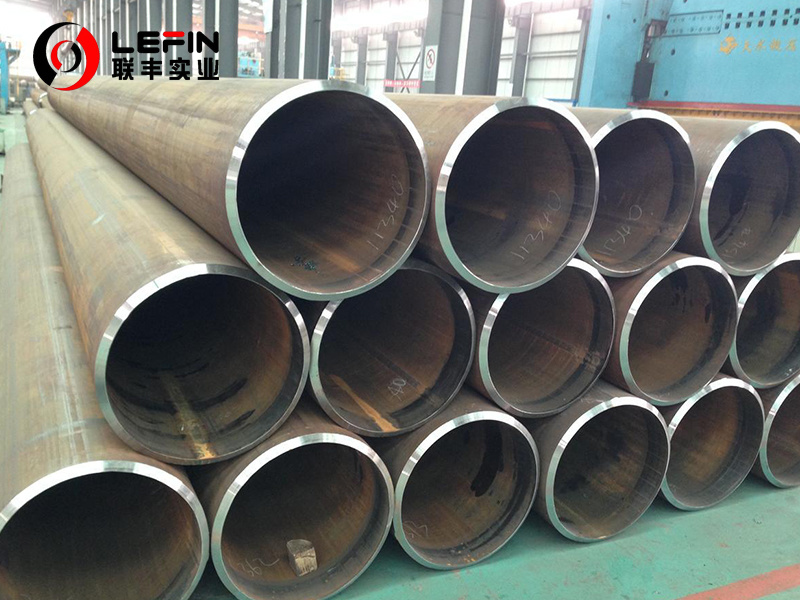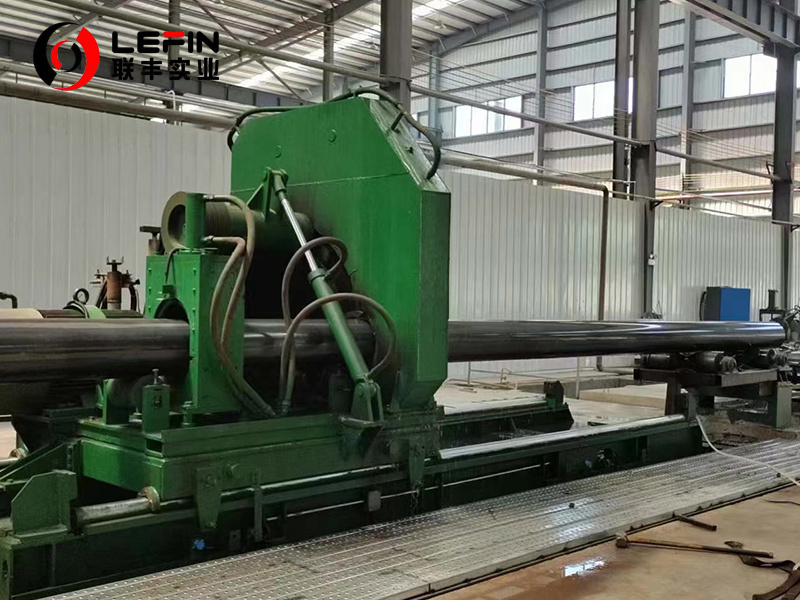

- Details
-
ASTM A36 HRC steel pipe is one of the most widely used carbon structural steels worldwide, renowned for its reliable mechanical properties, excellent processability and economy.
Detailed project description
Name and Standard ASTM A36, in accordance with the American Society for Testing and Materials standard ASTM A36/A36M. The A36 in the name is derived from its minimum yield strength of 36 KSI (approximately 250 MPa).
It should be particularly noted that standards usually do not directly stipulate the requirements for Rockwell hardness C scale (HRC), but rather pay more attention to performance indicators such as Brinell hardness (HB) or tensile strength.
In addition to steel pipes, the more common product forms of ASTM A36 include steel plates, section steels (such as H-beams, I-beams, Angle steels) and bars.
Key mechanical properties
Yield strength
≥ 250 MPa
Tensile strength
400-550 MPa
Elongation after fracture
≥ 20% (measuring ductility)
Hardness
The typical Brinell hardness (HB) range is approximately 119-162 HB.
According to the hardness conversion table, this roughly corresponds to a Rockwell hardness B scale (HRB) of approximately 65-74, or a Rockwell hardness C scale (HRC) of approximately 12-17. Some materials suggest that the range of HRC as high as 58-80 May be misunderstood or incorrect.
Typical chemical composition
Carbon (C)
≤ 0.25% - 0.29% (low carbon ensures good weldability and toughness)
Manganese (Mn)
≤ 0.80% - 1.20% (enhances strength and hardness)
Phosphorus (P), Sulfur (S)
All ≤ 0.04% - 0.05% (strictly controlled harmful impurities)
Silicon (Si)
≤ 0.40% (deoxidizer)
copper (Cu)
≤ 0.20% or ≥ 0.20% (slight corrosion resistance may be provided when specified)

Main features - Excellent weldability:
Almost all welding processes can be adopted, and preheating and post-weld heat treatment are usually not required (except for thick plates or extreme environments). - Good cold and hot workability: Easy to bend, stamp, shear and forge. Economic efficiency: Low cost, readily available raw materials, and high cost performance.
Common application fields - Architecture and Bridges
Factory building frames, building beams and columns, bridge structures, etc. - Mechanical manufacturing: equipment frames, bases, guardrails, toolboxes, etc. - Transportation: Truck chassis components, trailer structures, etc. General manufacturing: various brackets, flanges, connectors, etc.
Key points for processing and purchasing
When actually processing and purchasing ASTM A36 steel pipes, there are several key points to pay attention to:
- Welding performance:A36 steel has excellent welding performance due to its low carbon equivalent. Common welding methods such as manual arc welding (SMAW) and gas metal arc welding (GMAW/MIG) are all applicable. For materials with a thickness of less than 20 millimeters, preheating is usually not required for welding at room temperature.
- Corrosion resistance:A36 steel itself is not corrosion-resistant. If it is used in a damp or corrosive environment, surface protection measures must be considered, such as hot-dip galvanizing, spraying or brushing anti-corrosion coatings.

Purchasing considerations:
- Clarify requirements: Clearly state the specifications of the steel pipes you need (outer diameter, wall thickness, length), the execution standard (ASTM A36), and the delivery condition (such as hot-rolled).
- Hardness requirements: If there are special requirements for hardness, direct communication with the supplier should be conducted and the hardness acceptance criteria should be clearly stated in the order.
- Quality documents: Suppliers are required to provide Material certificates (MTC) to ensure that the material composition and performance comply with standards.
ASTM A36 HRC STEEL PIPE
Subcategory
Keyword
- Details
-
ASTM A36 HRC steel pipe is one of the most widely used carbon structural steels worldwide, renowned for its reliable mechanical properties, excellent processability and economy.
Detailed project description
Name and Standard ASTM A36, in accordance with the American Society for Testing and Materials standard ASTM A36/A36M. The A36 in the name is derived from its minimum yield strength of 36 KSI (approximately 250 MPa).
It should be particularly noted that standards usually do not directly stipulate the requirements for Rockwell hardness C scale (HRC), but rather pay more attention to performance indicators such as Brinell hardness (HB) or tensile strength.
In addition to steel pipes, the more common product forms of ASTM A36 include steel plates, section steels (such as H-beams, I-beams, Angle steels) and bars.
Key mechanical properties
Yield strength
≥ 250 MPa
Tensile strength
400-550 MPa
Elongation after fracture
≥ 20% (measuring ductility)
Hardness
The typical Brinell hardness (HB) range is approximately 119-162 HB.
According to the hardness conversion table, this roughly corresponds to a Rockwell hardness B scale (HRB) of approximately 65-74, or a Rockwell hardness C scale (HRC) of approximately 12-17. Some materials suggest that the range of HRC as high as 58-80 May be misunderstood or incorrect.
Typical chemical composition
Carbon (C)
≤ 0.25% - 0.29% (low carbon ensures good weldability and toughness)
Manganese (Mn)
≤ 0.80% - 1.20% (enhances strength and hardness)
Phosphorus (P), Sulfur (S)
All ≤ 0.04% - 0.05% (strictly controlled harmful impurities)
Silicon (Si)
≤ 0.40% (deoxidizer)
copper (Cu)
≤ 0.20% or ≥ 0.20% (slight corrosion resistance may be provided when specified)

Main features - Excellent weldability:
Almost all welding processes can be adopted, and preheating and post-weld heat treatment are usually not required (except for thick plates or extreme environments). - Good cold and hot workability: Easy to bend, stamp, shear and forge. Economic efficiency: Low cost, readily available raw materials, and high cost performance.
Common application fields - Architecture and Bridges
Factory building frames, building beams and columns, bridge structures, etc. - Mechanical manufacturing: equipment frames, bases, guardrails, toolboxes, etc. - Transportation: Truck chassis components, trailer structures, etc. General manufacturing: various brackets, flanges, connectors, etc.
Key points for processing and purchasing
When actually processing and purchasing ASTM A36 steel pipes, there are several key points to pay attention to:
- Welding performance:A36 steel has excellent welding performance due to its low carbon equivalent. Common welding methods such as manual arc welding (SMAW) and gas metal arc welding (GMAW/MIG) are all applicable. For materials with a thickness of less than 20 millimeters, preheating is usually not required for welding at room temperature.
- Corrosion resistance:A36 steel itself is not corrosion-resistant. If it is used in a damp or corrosive environment, surface protection measures must be considered, such as hot-dip galvanizing, spraying or brushing anti-corrosion coatings.

Purchasing considerations:
- Clarify requirements: Clearly state the specifications of the steel pipes you need (outer diameter, wall thickness, length), the execution standard (ASTM A36), and the delivery condition (such as hot-rolled).
- Hardness requirements: If there are special requirements for hardness, direct communication with the supplier should be conducted and the hardness acceptance criteria should be clearly stated in the order.
- Quality documents: Suppliers are required to provide Material certificates (MTC) to ensure that the material composition and performance comply with standards.
Related products
Product Consulting

Address: Hengtai Road,Daqiuzhuang Town,Jinghai County,Tianjin,China
Mob: +8615122229899(whatspp)
Phone: +86 22 58171905
Fax: +86 22 58171902
E-mail:info@lefinsteel.com
Get company updates

Tianjin Lefin Industrial Co.,Ltd. All rights reserved City sub-station SEO www.300.cn

